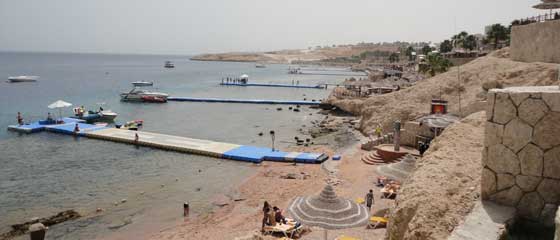Shark's Bay Beach
Shark Bay offers some of the best diving in the world and is one of the best starting points for Red Sea packages. Adventurers: Whether you prefer diving in the Jackson Reef area or riding a camel through the desert, Shark Bay is full of adventures. The coral reefs that fill the bay make it a suitable place to dive and enjoy all these attractive sea creatures. It is very safe and you will also come with experienced sneezers in this field from Happy Egypt.

How to get to Shark Bay Beach?
If you are planning to visit and explore Shark Bay on your own either from Chalok, Mae Haad or Sairee, you can travel there by taxi, Longtail or scooter. You can walk there from any of the main villages and it will take from 45 minutes to one hour, depending on the departure point. During your visit to Sharm El Sheikh, do not miss this opportunity and spend an adventurous time exploring this wonderful bay.

Can you swim in Shark Bay in Sharm El Sheikh?
Yes, the bay is very safe for swimming or diving. You can enjoy it and spend a time of calm and relaxation. Upon arrival at Sharm El Sheikh port, your tour guide from Happy Egypt will pick you up at the port exit and take a comfortable, air-conditioned bus to Shark Bay Beach. Relax on the beach and enjoy a warm Sharm El Sheikh tan and Sharm El Sheikh excursions. You can snorkel and swim in the clear waters of the Red Sea.

Why is it called Shark Bay in Sharm El Sheikh?
Different stories are told about the origin of the bay's name. Some say that until about 12 years ago, there were actually sharks inhabiting the bay, and others say that in fact some tourists mistook the mantas for sharks there, hence the name. For everyone who loves diving trips in Sharm El Sheikh, your choice of the bay is Important choices that provide you with a happy trip full of adventures in your Egypt travel packages.

What makes Shark Bay special?
Shark Bay is one of the world's most important and safest bastions of dugong protection, with a population of approximately 11,000. Increasing numbers of humpback and southern right whales use it, and a famous group of bottlenose dolphins live in the Gulf.

-webp.webp)


















-webp.webp)




-webp.webp)
-webp-webp.webp)
-webp-webp.webp)
-webp-webp.webp)
-webp-webp.webp)
-webp-webp.webp)
-webp-webp.webp)
-webp-webp.webp)
-webp-webp.webp)
-webp-webp.webp)
-webp-webp.webp)
-webp.webp)
-webp-webp.webp)
-webp-webp.webp)
-webp.webp)
-webp.webp)
-webp.webp)
-webp-webp.webp)
-webp.webp)
-webp-webp.webp)
-webp.webp)
-webp.webp)
-webp.webp)
-webp.webp)
-webp.webp)
-webp-webp.webp)
-webp-webp.webp)
-webp-webp.webp)
-webp-webp.webp)
-webp-webp.webp)
-webp-webp.webp)
-webp-webp.webp)
-webp.webp)
-webp-webp.webp)
-webp-webp.webp)
-webp-webp.webp)
-webp-webp.webp)
-webp-webp.webp)
-webp-webp.webp)
-webp-webp.webp)
-webp-webp.webp)
-webp-webp.webp)
-webp-webp.webp)
-webp-webp.webp)
-webp-webp.webp)
-webp-webp.webp)
-webp-webp.webp)
-webp.webp)
-webp.webp)
-webp.webp)
-webp.webp)



